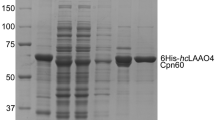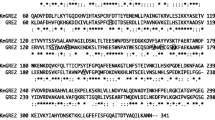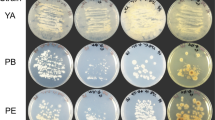Abstract
l-Amino acid oxidases (L-AAOs) catalyze the oxidative deamination of l-amino acids to the corresponding α-keto acids, ammonia, and hydrogen peroxide. l-AAOs are homodimeric enzymes with FAD as a non-covalently bound cofactor. They are of potential interest for biotechnological applications. However, heterologous expression has not succeeded in producing large quantities of active recombinant l-AAOs with a broad substrate spectrum so far. Here, we report the heterologous expression of an active l-AAO from the fungus Rhizoctonia solani in Escherichia coli as a fusion protein with maltose-binding protein (MBP) as a solubility tag. After purification, it was possible to remove the MBP-tag proteolytically without influencing the enzyme activity. MBP-rsLAAO1 and 9His-rsLAAO1 converted basic and large hydrophobic l-amino acids as well as methyl esters of these l-amino acids. The progress of the conversion of l-phenylalanine and l-leucine into the corresponding α-keto acids was determined by HPLC and 1H-NMR analysis of reaction mixtures, respectively. Enzymatic activity was stimulated 50–100-fold by SDS treatment. K m values ranging from 0.9–10 mM and v max values from 3 to 10 U mg−1 were determined after SDS activation of 9His-rsLAAO1 for the best substrates. The enzyme displayed a broad pH optimum between pH 7.0 and 9.5. In summary, a successful overexpression of recombinant l-AAO in E. coli was established that results in a promising enzymatic activity and a broad substrate spectrum for biotechnological application.







Similar content being viewed by others
References
Bender AE, Krebs HA (1950) The oxidation of various synthetic alpha-amino-acids by mammalian D-amino-acid oxidase, L-amino-acid oxidase of cobra venom and the L-amino-acid and D-amino-acid oxidases of Neurospora-crassa. Biochem J 46:210–219
Bifulco D, Pollegioni L, Tessaro D, Servi S, Molla G (2013) A thermostable L-aspartate oxidase: a new tool for biotechnological applications. Appl Microbiol Biotechnol 97:7285–7295. doi:10.1007/s00253-013-4688-1
Bradford MM (1976) Rapid and sensitive method for quantitation of microgram quantities of protein utilizing principle of protein-dye binding. Anal Biochem 72:248–254. doi:10.1006/abio.1976.9999
Cheng CH, Yang CA, Liu SY, Lo CT, Huang HC, Liao FC, Peng KC (2011) Cloning of a novel L-amino acid oxidase from Trichoderma harzianum ETS 323 and bioactivity analysis of overexpressed L-amino acid oxidase. J Agric Food Chem 59:9142–9149. doi:10.1021/jf201598z
Cubeta MA, Thomas E, Dean RA, Jabaji S, Neate SM, Tavantzis S, Toda T, Vilgalys R, Bharathan N, Fedorova-Abrams N, Pakala SB, Pakala SM, Zafar N, Joardar V, Losada L, Nierman WC (2014) Draft genome sequence of the plant-pathogenic soil fungus Rhizoctonia solani anastomosis group 3 strain Rhs1AP. Genome announcements 2. doi:10.1128/genomeA.01072-14
Espin JC, Wichers HJ (1999) Activation of a latent mushroom (Agaricus bisporus) tyrosinase isoform by sodium dodecyl sulfate (SDS). Kinetic properties of the SDS-activated isoform. J Agric Food Chem 47:3518–3525. doi:10.1021/jf981275p
Faust A, Niefind K, Hummel W, Schomburg D (2007) The structure of a bacterial (L)-amino acid oxidase from Rhodococcus opacus gives new evidence for the hydride mechanism for dehydrogenation. J Mol Biol 367:234–248. doi:10.1016/j.jmb.2006.11.071
Ferrer M, Chernikova TN, Timmis KN, Golyshin PN (2004) Expression of a temperature-sensitive esterase in a novel chaperone-based Escherichia coli strain. Appl Environ Microbiol 70:4499–4504. doi:10.1128/aem.70.8.4499-4504.2004
Floudas D, Binder M, Riley R, Barry K, Blanchette RA, Henrissat B, Martinez AT, Otillar R, Spatafora JW, Yadav JS, Aerts A, Benoit I, Boyd A, Carlson A, Copeland A, Coutinho PM, de Vries RP, Ferreira P, Findley K, Foster B, Gaskell J, Glotzer D, Gorecki P, Heitman J, Hesse C, Hori C, Igarashi K, Jurgens JA, Kallen N, Kersten P, Kohler A, Kuees U, Kumar TKA, Kuo A, LaButti K, Larrondo LF, Lindquist E, Ling A, Lombard V, Lucas S, Lundell T, Martin R, McLaughlin DJ, Morgenstern I, Morin E, Murat C, Nagy LG, Nolan M, Ohm RA, Patyshakuliyeva A, Rokas A, Ruiz-Duenas FJ, Sabat G, Salamov A, Samejima M, Schmutz J, Slot JC, John FS, Stenlid J, Sun H, Sun S, Syed K, Tsang A, Wiebenga A, Young D, Pisabarro A, Eastwood DC, Martin F, Cullen D, Grigoriev IV, Hibbett DS (2012) The Paleozoic origin of enzymatic lignin decomposition reconstructed from 31 fungal genomes. Science 336:1715–1719. doi:10.1126/science.1221748
Geueke B, Hummel W (2002) A new bacterial L-amino acid oxidase with a broad substrate specificity: purification and characterization. Enzym Microb Technol 31:77–87. doi:10.1016/s0141-0229(02)00072-8
Geueke B, Hummel W (2003) Heterologous expression of Rhodococcus opacus L-amino acid oxidase in Streptomyces lividans. Protein Expr Purif 28:303–309. doi:10.1016/s1046-5928(02)00701-5
Hanson RL, Bembenek KS, Patel RN, Szarka LJ (1992) Transformation of N-epsilon-CBZ-L-lysine to CBZ-L-oxylysine using L-amino-acid oxidase from Providencia-alcalifaciens and L-2-hydroxy-isocaproate dehydrogenase from Lactobacillus-confusus. Appl Microbiol Biotechnol 37:599–603
Hossain GS, Li J, Shin H-d, Du G, Liu L, Chen J (2014) L-Amino acid oxidases from microbial sources: types, properties, functions, and applications. Appl Microbiol Biotechnol 98:1507–1515. doi:10.1007/s00253-013-5444-2
Kapust RB, Waugh DS (1999) Escherichia coli maltose-binding protein is uncommonly effective at promoting the solubility of polypeptides to which it is fused. Protein Sci 8:1668–1674
Kasai K, Hashiguchi K, Takahashi H, Kasai A, Takeda S, Nakano M, Ishikawa T, Nakamura T, Miura T (2015) Recombinant production and evaluation of an antibacterial l-amino acid oxidase derived from flounder Platichthys stellatus. Appl Microbiol Biotechnol 99:6693–6703. doi:10.1007/s00253-015-6428-1
Laemmli UK (1970) Cleavage of structural proteins during the assembly of the head of bacteriophage T4. Nature 227:680–685
Liu L, Hossain GS, Shin HD, Li JH, GC D, Chen J (2013) One-step production of alpha-ketoglutaric acid from glutamic acid with an engineered L-amino acid deaminase from Proteus mirabilis. J Biotechnol 164:97–104. doi:10.1016/j.jbiotec.2013.01.005
Moore BM, Flurkey WH (1990) Sodium dodecyl-sulfate activation of a plant polyphenoloxidase - effect of sodium dodecyl-sulfate on enzymatic and physical characteristics of purified broad bean polyphenoloxidase. J Biol Chem 265:4982–4988
Moustafa IM, Foster S, Lyubimov AY, Vrielink A (2006) Crystal structure of LAAO from Calloselasma rhodostoma with an L-phenylalanine substrate: insights into structure and mechanism. J Mol Biol 364:991–1002. doi:10.1016/j.jmb.2006.09.032
Nakai K, Horton P (1999) PSORT: a program for detecting sorting signals in proteins and predicting their subcellular localization. Trends Biochem Sci 24:34–35. doi:10.1016/s0968-0004(98)01336-x
Nuutinen JT, Marttinen E, Soliymani R, Hilden K, Timonen S (2012) L-Amino acid oxidase of the fungus Hebeloma cylindrosporum displays substrate preference towards glutamate. Microbiology 158:272–283. doi:10.1099/mic.0.054486-0
Nuutinen JT, Timonen S (2008) Identification of nitrogen mineralization enzymes, L-amino acid oxidases, from the ectomycorrhizal fungi Hebeloma spp. and Laccaria bicolor. Mycol Res 112:1453–1464. doi:10.1016/j.mycres.2008.06.023
Petersen TN, Brunak S, von Heijne G, Nielsen H (2011) SignalP 4.0: discriminating signal peptides from transmembrane regions. Nat Meth 8:785–786. doi:10.1038/nmeth.1701
Pollegioni L, Molla G (2011) New biotech applications from evolved D-amino acid oxidases. Trends Biotechnol 29:276–283. doi:10.1016/j.tibtech.2011.01.010
Pollegioni L, Motta P, Molla G (2013) L-Amino acid oxidase as biocatalyst: a dream too far ? Appl Microbiol Biotechnol 97:9323–9341
Tan NH, Saifuddin MN (1991) Substrate-specificity of king cobra (Ophiophagus-hannah) venom L-amino-acid oxidase. Int J Biochem 23:323–327
Tang JD, Perkins AD, Sonstegard TS, Schroeder SG, Burgess SC, Diehl SV (2012) Short-read sequencing for genomic analysis of the brown rot fungus Fibroporia radiculosa. Appl Environ Microbiol 78:2272–2281. doi:10.1128/aem.06745-11
Tashiro Y, Rodriguez GM, Atsumi S (2015) 2-Keto acids based biosynthesis pathways for renewable fuels and chemicals. J Ind Microbiol Biotechnol 42:361–373. doi:10.1007/s10295-014-1547-8
Thayer PS, Horowitz NH (1951) The L-amino acid oxidase of Neurospora. J Biol Chem 192:755–767
Tong HC, Chen W, Shi WY, Qi FX, Dong XZ (2008) SO-LAAO, a novel L-amino acid oxidase that enables Streptococcus oligofermentans to outcompete Streptococcus mutans by generating H2O2 from peptone. J Bacteriol 190:4716–4721. doi:10.1128/jb.00363-08
Ullah A, Souza TACB, Abrego JRB, Betzel C, Murakami MT, Arni RK (2012) Structural insights into selectivity and cofactor binding in snake venom L-amino acid oxidases. Biochem Biophys Res Com 421:124–128. doi:10.1016/j.bbrc.2012.03.129
Vanboven A, Tan PST, Konings WN (1988) Purification and characterization of a dipeptidase from Streptococcus-cremoris Wg2. Appl Environ Microbiol 54:43–49
Whitby LG (1953) A new method for preparing flavin-adenine dinucleotide. Biochem J 54(3):437–442
Wittenberg C, Triplett EL (1985) A detergent-activated tyrosinase from Xenopus-laevis .2. Detergent activation and binding. J Biol Chem 260:2542–2546
Zhang HM, Teng M, Niu LW, Wang YB, Wang YZ, Liu Q, Huang QQ, Hao Q, Dong YH, Liu P (2004) Purification, partial characterization, crystallization and structural determination of AHP-LAAO, a novel L-amino-acid oxidase with cell apoptosis-inducing activity from Agkistrodon halys pallas venom. Acta Crystallog Sect D 60:974–977. doi:10.1107/s0907444904000046
Zhou MJ, Diwu ZJ, PanchukVoloshina N, Haugland RP (1997) A stable nonfluorescent derivative of resorufin for the fluorometric determination of trace hydrogen peroxide: applications in detecting the activity of phagocyte NADPH oxidase and other oxidases. Anal Biochem 253:162–168. doi:10.1006/abio.1997.2391
Acknowledgements
We thank Denise Weinberg and Thomas Geisler for excellent technical assistance.
Author information
Authors and Affiliations
Corresponding author
Ethics declarations
Funding
This study was funded by Deutsche Forschungsgemeinschaft (grant number KO3580/4-1).
Conflict of interest
The authors declare that they have no conflict of interest.
Ethical approval
This article does not contain any studies with human participants or animals performed by any of the authors.
Rights and permissions
About this article
Cite this article
Hahn, K., Neumeister, K., Mix, A. et al. Recombinant expression and characterization of a l-amino acid oxidase from the fungus Rhizoctonia solani . Appl Microbiol Biotechnol 101, 2853–2864 (2017). https://doi.org/10.1007/s00253-016-8054-y
Received:
Revised:
Accepted:
Published:
Issue Date:
DOI: https://doi.org/10.1007/s00253-016-8054-y




